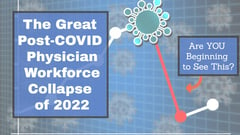 The business mantra about the pandemic goes like this:
The business mantra about the pandemic goes like this:
COVID didn't change anything, it just dramatically accelerated what was already going to happen.
An example from healthcare is virtual/digital doctor visits. They were always going to become more common/popular. COVID birthed a whole new virtual medicine function and drove 5 years worth of innovation in organizations nation-wide ... in just 60 days.
I fear the same acceleration of existing trends is about to happen in the physician workforce. Unfortunately this could be the radical acceleration of a negative trend we have been dreading for a while.
For a decade, we have all seen the projections of a 120,000 doctor shortage in the USA 2030.
What if this same shortage develops in just 18 months?
- COVID is about to activate the Boomer Physician Retirement Cliff.
- I am very suspicious we will be over 100,000 doctors short by as soon as 2023.
- Let me give you my data points in support of my concerns.
NOTE: this acute physician shortage is potentially a good thing for physician wellness. It will drive leadership to a laser focus on a single metric: Recruitment and Retention. When employers battle it out to be the employer of choice, I believe it is possible for the remaining physicians to come out in better shape than in this last decade.
PLEASE LEAVE A COMMENT and tell us what You Think!
Start Building Your Corporate Physician Wellness Strategy
Our Four Most Popular Options for Your First Step
The Setup
- More than two of every five active physicians in the U.S. will be 65 or older within the next decade. (40% = what a retirement cliff looks like when you are standing at the top!)
- AAMC’s 2019 National Physician Survey found 40% of the country’s practicing physicians felt burned out at least once a week. This was Before COVID-19. All surveys since then have shown higher levels of stress and burnout.
- The United States could see a shortage of between 37,800 and 124,000 physicians by 2034. (I hope these projections take into effect the Wild Card I point out below!!)
Reference: AAMC June 2021
The Complexities of Physician Supply and Demand: Projections From 2019 to 2034
https://www.aamc.org/media/54681/download
Are You Concerned Yet?
We are sitting on a cohort of doctors clustered around age 65 that represents 40% of the USA physician workforce. The actual number is right around 400,000 MD's or DO's -- all of whom are currently seeing patients mind you!
Look around your ward, wing, service or organization. How many grey haired doctors can you count who are over 60 years old?
In a decade, they will all be gone.
- What if these doctors retire sooner?
- What could cause that?
- What effect might that mass exodus have on the quality of care in the USA?
- What effect might that mass exodus have on the stress and burnout of the physicians who remain?
Meet Our Certified Physician Coaches
Book a Discovery Call to find a Way Forward
No Cost, No Obligation, Completely Confidential
The Hammer Blow
The recovery from the COVID economic downturn has been slowed by some unique circumstances. Most downturns are caused when jobs dry up. Now we have millions of open job positions going unfilled.
Several of the entry-level jobs with the most severe shortages are support staff in physician practices. Ask your HR department how many open and vacant Medical Assistant (MA) positions exist in your organization. You will be shocked by their answer.
Huge numbers of M.A.s were let go at the height of the COVID crisis. Those jobs are now open again. No one is taking them.
Right now, you can't hire an M.A. for Love or Money
They saw the carnage of the pandemic on TV. There are loads of easier jobs paying better than M.A. wages in every job market in the USA. The situation is so dire, no one can predict when your office or hospital will be fully staffed no matter how far they gaze into the future.
Why am I talking about M.A.'s?
What does this have to do with physicians retiring?
The answer is everything.Back before COVID, burnout rates were at 40 - 50% at a time when all the doctors had M.A.s and Nurses helping them get through the patients, the charting and the InBox.
NOW ... your M.A. is gone. Sure the job is open. No one is going to fill it. You can make more at Dick's Drive In without risking your life or dealing with sick patients.
So here you are, day after day, rooming your own patients, dealing with all the inbound calls, texts and InBox work by yourself.
In the last couple of months dozens of doctors have told me this same story:
Our wing of six doctors used to have six M.A.s and two LPN's doing triage and phone calls. NOW, we only have 3 M.A.s between us and all the nurses are gone.
We are lumping all the work on those remaining 3 so we can keep seeing patients. I am concerned they will all walk out at once. There is no end in sight. One of my partners quit last month and two more are seriously talking about it.
- What does such brutal understaffing do to a Boomer Doctor's stress and burnout levels?
- What if that same Boomer Doctor is actually financially capable of retiring? Many physicians in their sixties work well past the point when they can retire financially. It is a difficult transition for many. An absence of office support is a perfect last straw.
- Look around your organization. How many doctors are 60 and over? Sure, you were expecting them to retire sometime in the next few years. You were probably thinking you would worry about that contingency when they put in their notice, kicking the can down the road with fingers crossed. Right?
- NOW IMAGINE THIS:
ALL OF THEM ARE GONE BY THIS TIME NEXT YEAR !Realize that THIS COULD HAPPEN.
 The Wild Card that Could Make Everything Worse
The Wild Card that Could Make Everything Worse
1) Notice that all the retiring doctors are from the generation who had no residency work hour restrictions.
They are old school boomers with a certain work ethic. Look at the number of patients they see in a day ... and that they consider to be a normal work load.
Notice that all the remaining doctors are from the generation who graduated from residency programs with work hour restrictions in place.They have a different work ethic. Notice how many patients they see in a day ... and consider to be their maximal work load.
QUESTION:
How many Gen X or Millennial doctors (those from work hour restricted residency programs) does it take to replace each of the retiring boomer docs?Is the proper ratio 2:1 or 3:1 ?
Just how many new physicians will you need to hire, onboard and retain for each retiring boomer doc? This is another widely understood challenge to all future physician staffing calculations. We all know this is not an apples to apples comparison and the conversion rate is NOT one to one. What's your number?
I sure hope that conversion ratio is factored into the physician work shortage calculations I referenced above.
 How does this potentially help your Physician Wellness Program?
How does this potentially help your Physician Wellness Program?
The short answer is FOCUS.
When you are launching your corporate wellness strategy, you could choose from a number of metrics to track the Return on Investment of your projects. You could look at quality, safety, patient satisfaction and more.
In these extreme workforce shortage conditions a different metric will become the only thing that matters. That metric is:
Recruitment and Retention
From this point forward, your organization's wellness strategy should be designed to prove you are the EMPLOYER OF CHOICE in your geographic region.
Your goal is to take better care of your physicians and staff than the competition by design and on purpose.
- Smooth systems of patient and information flow
- Adequate numbers of qualified staff to carry the workload
- Collaboration in the design of your work flows - you listen and accept feedback
- A culture of support - someone has my back.
Any candidate who interviews at the other organizations in the area must be able to see and feel you are the best, if not the only, reasonable option.
Fortunately that is only one of the three competitive advantages of a well designed physician wellness strategy.
PLEASE LEAVE A COMMENT
- What is your level of concern about physician staffing in the wake of COVID?
- If you are 60 or older, what would it take for you to call it quits?
- Is your organization the employer of choice in your region?
If not, why not?


